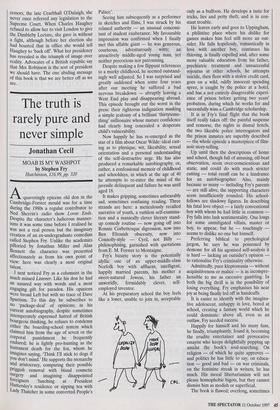Here's to you, Mrs Robinson
C. D. C. Armstrong
THE WOMAN WHO TOOK POWER IN THE PARK by Lorna Siggins Mainstream, £14.99, pp. 240 Mary Robinson has recently resigned as President of Ireland in order to become the United Nations High Commissioner for Human Rights. As the first woman to have held the office of Irish President she has come to symbolise the deep changes in Irish public life and social attitudes which have transformed the Republic over the last decade or so. The Celtic Sweden could have had no more fitting head of state than this radical barrister and sometime Irish Labour Party Senator.
The Woman Who Took Power in the Park is, to date, the second biography of the President. The title may need some elucidation (for non-Irish readers at least). 'The Park' is Phoenix Park in Dublin, where the official residence of the President is situated (in happier days it was home to the Lord Lieutenant of Ireland). And Mrs Robinson did not, as the title might seem to imply, attain office after a coup d'etat. She was directly elected some seven years ago, although Lorna Siggins fails to mention that she was not quite the first choice of her people: polling 82,000 fewer first preference votes than her Fianna Fail rival, the late Brian Lenihan, she was elected by second preference votes transferred from the Fine Gael candidate.
Miss Siggins, an Irish Times journalist, is not quite at home in the worlds of politics and the law with which this book must inevitably deal. Her description of Fine Gael as 'right of centre' would not be shared by all members of that party. Nor was Eamon de Valera the 'architect' of the Irish Republic: the Republic was proclaimed by de Valera's opponent John A. Costello. She consistently appends an unnecessary `e' to the surname of the jurisprudentialist H. L. A. Hart. Her carelessness extends to the career of her subject. Writing of Robinson in 1966, she refers to her as a barrister; Robinson was not called to the bar until the following year.
Worse than the carelessness is the padding. The reader hardly needs her potted histories of the Great Famine or feminism. At those points in Robinson's career when deeper analysis is called for, the reader is disappointed. We are not told, for example, precisely what the Fian- na Fail minister Padraig Flynn meant when, in the course of the presidential election, he referred to Mrs Robinson's 'new interest in the family', nor are we told why this remark, which some regard as the turning-point of the campaign, aroused such controversy.
This omission is in fact typical of the author's largely uncritical treatment of Mrs Robinson (though we should be grateful at least that the undistinguished prose is not too gushing). It is no surprise, therefore, that Siggins fails to draw attention to a disturbing feature of Robinson's character: her inconsistency. In her public utterances Robinson has shown a remarkable talent for adapting her views to suit the occasion. In 1971 she told an interviewer for a Catholic magazine that she accepted Humanae Vitae (the papal encyclical of 1968 forbidding artificial contraception), when she was at about that time a co- sponsor of a bill to legalise the sale of contraceptives. Again, during the presiden- tial election campaign she told one news- paper that she supported the right to life of the unborn, 'as guaranteed by the constitu- tion', when seven years before she had opposed the constitutional amendment which enshrined that right. Later on in the campaign she demanded an apology when a Fianna Fail parliamentarian described her as 'pro-divorce, pro-contraception, and pro-abortion', apparently forgetting that her support for the first two issues was well-documented. That episode is not mentioned in this biography.
Mrs Robinson's reputation for sympathy with the Unionists of Ulster seems to rest on somewhat shaky foundations. It is true that she resigned from the Irish Labour party in protest at the Anglo-Irish Agree- ment, but she had previously been an opponent of internment in Northern Ireland. Her frequent trips across the border after her election outraged many Unionists, who saw these visits as giving physical expression to the Irish constitu- tion's claim to sovereignty over Northern Ireland. She declined to apologise for shak- ing hands with Gerry Adams in 1993 — over a year before the first IRA ceasefire — though she later expressed regret for having shaken hands with General Pinochet on a visit to Chile. In York last year she made wild allegations against the RUC, strange conduct for a head of state visiting a friendly neighbour.
It is hard to see what legacy she has left her own country. Certainly she has come to symbolise changes in Irish society, but these changes would have come about even without her election. Her presidency has been more a matter of style than of sub- stance. The constitutional position of the office has remained unaltered, and she failed to use her constitutional powers to their full extent. Unlike one of her prede- cessors, the late Cearbhall 0.'Dalaigh, she never once referred any legislation to the Supreme Court. When Charles Haughey refused to allow her to visit London to give the Dimbleby Lecture, she gave in without a fight, although before her election she had boasted that in office she would tell Haughey to 'back off. What her presidency has revealed is the triumph of image over reality. Advocates of a British republic say that Mrs Robinson is the sort of president we should have. The one abiding message of this book is that we are better off as we are.



















































































 Previous page
Previous page